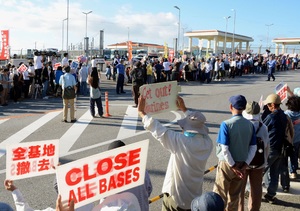The resolution on new base construction project at Henoko in Okinawa that we submitted to - and was approved overwhelmingly by - the Saint Paul Convention has now been finally approved in the referendum of all members (591 to 5). Now is the time to put it to work. It is written as an appeal to the US Government Accountability Office (GAO) to launch an investigation of that project. Last year’s GAO report on the Marines in the Asia-Pacific contained veiled criticisms of the Henoko project, so there is a real possibility that they might take this up big time.
But to do that they need a nudge from Congress. The letter form below makes it very easy to send the text of this resolution to your congresspeople. Type in your zip code and it comes up with the names of the reps from your district. Push the button and it sends off the resolution to all three of those reps. VFP has some 3000 members. Numbers like that could produce a very big nudge.
Okinawa is moving toward crisis. The Japanese Government actually started dumping fill (dirt) onto the sea off Cape Henoko on 14 December. The Okinawan people and their Prefectural government are doing everything they can to to stop it if. Their vigil at the gate has continued for more that 5000 days; their actual sit-in (blocking construction vehicles) more than 1000. A move by GAO could have an impact. Please take a few minutes to send this letter off.
If you have already signed, can you forward to a friend? It's so important that we get as many letters sent as possible!

A message from VFP-Ryukyus/Okinawa Chapter Kokusai (VFP-ROCK)
C. Douglas Lummis, Coordinator
Yesterday (16 January, 2019) I took the charter bus that carries people six days a week from Naha, Okinawa’s Prefectural capital, to USMC Camp Schwab, in Henoko, an hour and a half to the north. There they join a sit-in that has continued well over 1000 days, to block the hundreds of trucks that enter the base daily carrying dirt and crushed rock, which they dump into the bay to make two new airstrips and a deep water port for the Marines.
These sit-inners are mostly retired people – a resilient political class. They needn’t worry about future employment, or being fired from their retirement incomes. And they bear the memory of the Battle of Okinawa, and are committed, in the last chapters of their lives, to prevent war coming to their islands again.
But yesterday the route was changed. To avoid the sit-in, the Okinawa Defense Bureau has started filing the sea off Cape Henokoy also from ships. On the opposite side of Okinawa Island a mountain is being taken down, loaded into trucks (again hundreds), then dumped into cargo ships, which sail around the island and dump it into the sea at Henoko. So the bus took the people there, where they could block the trucks entering the pier area. Instead of sitting down, for which they can be carried away and incarcerated, they adopted the tactic of milling around in the crosswalk, for which they can be pushed aside, only to return when the light changes. At the end of the workday, the ship was still not loaded, to the great jubilation of the protesters.
While Okinawa comprises only .6% of the Japanese national territory, over 70% of the US military bases in Japan are located there. The question is, Why Okinawa?
The answer: because it’s Okinawa, once independent, then colonized, then annexed by Japan, with the Okinawans still today treated as second-class citizens. Forcing the base on Okinawa is a way of keeping it out of Japan proper. Okinawans call this structural discrimination.
This new base affronts the Okinawans’ dignity as an indigenous people (recognized by the U.N.) and their anti-war convictions. It will destroy the coral garden that is Oura Bay, and drive out the endangered Dugong from its northernmost habitat. It will cause more air, water and noise pollution, more accidents and crimes, especially crimes against women. But such appeals to the US and Japanese Governments have no effect. Japan’s attitude seems to be, Isn’t that what colonies are for, to keep those problems out of the homeland?
But in the US, national interest considerations may have some effect. In 2017 the US Government Accountability Office (GAO) made a study of the US military presence in the Asia Pacific. Subtly, the report expressed doubts that the Henoko project is in the US interest. Since then, reasons for doubt have increased:
Okinawa Defense Bureau soil tests show that where a seawall is to be built, parts of the sea bottom has the resilience of mayonnaise. A seawall there would sink out of sight.
Surrounding the location are scores of buildings, residences, condos, schools and electrical towers that violate US Defense Department height limit regulations, endangering both local people and Marine pilots.
Underneath the location are two earthquake faults.
Last November, despite the desperate efforts of the Japanese Government to put their man in office, anti-base Tamaki Denny won the Okinawa Governor’s election by a landslide.
Last December the Japanese Government (quietly) announced that the money appropriated for construction of the seawall on the Oura Bay side of Cape Henoko in 2018 has been returned to the treasury, as the work was not done. Moreover, no such money has been appropriated for 2019. This puts the project two additional years behind schedule. The official reporting this said it’s impossible to say when seawall construction will begin. Soil testing, begun in 2014, continues. The cost estimate has increased tenfold, much of that for the hundreds of riot police who daily drag sit-inners away from the gate.
Many experts believe that the engineering problems alone will probably prevent this project from being achieved. Why does the Japanese Government keep plugging on with it? Mainly, it seems, to save face. They can’t bear to lose to the Okinawans, or fail to deliver on their promise to the US. But even if they fail to build the base, their failed attempt can kill the sea around Henoko.
It seems certain that the Okinawa Defense Bureau is not giving the Marines or the US Government accurate information about the situation. This is where a GAO investigation would be useful. The trouble is, to start an investigation they need a nudge from Congress. So we have started a campaign to persuade Congress members to give the GAO that nudge. For anyone who wishes to participate in this, the URL attached below will show you how to do it (it’s easy):
Send your Letter Now: http://bit.ly/henokono
VFP-ROCK is confident that the Henoko boondoggle will not pass inspection.


